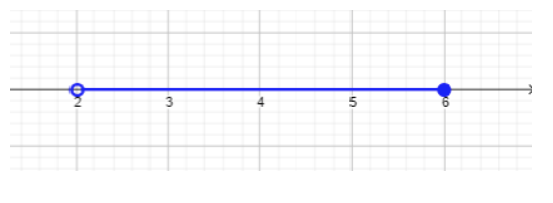10.2:求解和绘制不等式,以及用区间表示法写出答案
- Page ID
- 171328
\( \newcommand{\vecs}[1]{\overset { \scriptstyle \rightharpoonup} {\mathbf{#1}} } \) \( \newcommand{\vecd}[1]{\overset{-\!-\!\rightharpoonup}{\vphantom{a}\smash {#1}}} \)\(\newcommand{\id}{\mathrm{id}}\) \( \newcommand{\Span}{\mathrm{span}}\) \( \newcommand{\kernel}{\mathrm{null}\,}\) \( \newcommand{\range}{\mathrm{range}\,}\) \( \newcommand{\RealPart}{\mathrm{Re}}\) \( \newcommand{\ImaginaryPart}{\mathrm{Im}}\) \( \newcommand{\Argument}{\mathrm{Arg}}\) \( \newcommand{\norm}[1]{\| #1 \|}\) \( \newcommand{\inner}[2]{\langle #1, #2 \rangle}\) \( \newcommand{\Span}{\mathrm{span}}\) \(\newcommand{\id}{\mathrm{id}}\) \( \newcommand{\Span}{\mathrm{span}}\) \( \newcommand{\kernel}{\mathrm{null}\,}\) \( \newcommand{\range}{\mathrm{range}\,}\) \( \newcommand{\RealPart}{\mathrm{Re}}\) \( \newcommand{\ImaginaryPart}{\mathrm{Im}}\) \( \newcommand{\Argument}{\mathrm{Arg}}\) \( \newcommand{\norm}[1]{\| #1 \|}\) \( \newcommand{\inner}[2]{\langle #1, #2 \rangle}\) \( \newcommand{\Span}{\mathrm{span}}\)\(\newcommand{\AA}{\unicode[.8,0]{x212B}}\)
要求解不等式并绘制图表:
- 使用上一节中的不等式属性求解不等式。
- 在数字线上绘制解决方案集合的图表。
- 用间隔表示法写出解集。
求解不等式,在数字线上绘制解集合图,并用区间表示法显示解集:
- \(−1 ≤ 2x − 5 < 7\)
- \(x^2 + 7x + 10 < 0\)
- \(−6 < x − 2 < 4\)
解决方案
- \(\begin{array} &&−1 ≤ 2x − 5 < 7 &\text{Example problem} \\ &−1 + 5 ≤ 2x − 5 + 5 < 7 + 5 &\text{The goal is to isolate the variable \(x\),所以首先将不等式中的所有三个区域相加\(5\)。}\\ &4 ≤ 2x < 12 &\ text {Simplify。}\\ &\ dfrac {4} {2} ≤ 2x^2 <\ dfrac {4} {2} &\ text {全部除\(2\)以分离变量\(x\)。}\\ &2 ≤ x < 6 &\ text {最终答案写于不等式/解决方案集合形式。}\\ & [2, 6) &\ text {用区间表示法写的最终答案(更多详情请参阅间隔符号部分)}\ end {array}\)

- \(\begin{array} &&x^2 + 7x + 10 < 0 &\text{Example problem} \\ &(x + 5)(x + 2) < 0 &\text{Factor the polynomial.} \\ &(x + 5)(x + 2) < 0 &\text{The product must be less than \(0\),这意味着如果\((x + 5) > 0\),那么\((x + 2) < 0\)。 同样,if\((x + 5) < 0\),那么\((x + 2) > 0\)。}\\ & (x + 5) > 0 (x + 2) < 0 &\ text {Find the intersection of each of these inequalities.}\\ &x > −5 x < −2 &\ text {找出每个不等式的交点。} \ end {array}\)


\(\begin{array} &&\;\;\;−5 < x < −2 \;\;\;\;\;\;\;\;\;\;\;\;\;\;\;\;\;\;&\text{Final answer written in inequality/solution set form.} \\ &\;\;\;(−5, −2) \;\;\;\;\;\;\;\;\;\;\;\;\;\;\;\;\;\;&\text{Final answer written in interval notation (see section on Interval Notation for more details).} \end{array}\)
- \(\begin{array}&&−6 < x − 2 ≤ 4 &\text{Example problem} \\ &−6 + 2 < x − 2 + 2 ≤ 4 + 2 &\text{The goal is to isolate the variable \(x\),所以首先将不等式中的所有三个区域相加\(2\)。}\\ &−4 < x ≤ 6 &\ text {以不等式/解集形式写的最终答案。}\\ & (−4, 6] &\ text {用区间表示法写的最终答案(更多详情请参阅间隔表示法部分)。} \ end {array}\)

求解不等式,在数字线上绘制解集合图,并用区间表示法显示解集:
- \(0 ≤ x + 1 ≤ 4\)
- \(0 < 2(x − 1) ≤ 4\)
- \(6 < 2(x − 1) < 12\)
- \(x^2 − 6x − 16 < 0\)
- \(2x^2 − x − 15 > 0\)


